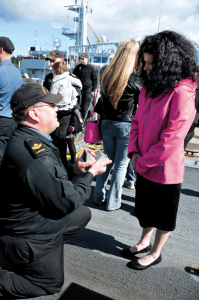Whitehorse and Nanaimo return home
By Lookout on Apr 20, 2015 with Comments 0

MS William Dennis proposes to Jenny Clark after arriving back from Operation Caribbe.
After a five week deployment on Operation Caribbe, in which HMCS Whitehorse and HMCS Nanaimo assisted in seizing a combined six metric tons of cocaine, the two ships arrived home last Wednesday to a crowd of cheering families and loved ones.
The ships sailed past Duntze Head for the traditional salute while the Naden Band serenaded the crowd. Waiting loved ones eagerly clutched flowers and balloons as the ramp was slowly lowered, by crane, onto the Y jetty.
The first step off the ship was taken by Master Seaman William Dennis of Whitehorse, who proposed to Jenny Clark on the ramp, before the two shared a customary first kiss.
Whitehorse and Nanaimo joined the U.S. Navy and Coast Guard on Feb. 23 as Canada’s contribution to the multinational Operation Martillo, which seeks to intercept trafficking by transnational organized crime in the Caribbean Basin and Eastern Pacific.
Operation Martillo has been strengthening international partnerships between the Western Hemisphere and European nations in a bid to improve regional security and deter future criminal activity.
Historically, interagency cooperation efforts such as Martillo have resulted in yearly seizures of millions of dollars of illicit drugs, while actively disrupting trafficking in international waters and airspaces around South and Central America.
“If drugs make it through the easier passages, Mexico for example, they can eventually get to North American markets,” said Whitehorse Commanding Officer, LCdr Christopher Rochon upon the ship’s return home.
“There have been traces of these drugs making it to Canada, so it’s good for our ships to be out there.”
The two ships acted in a supporting role to the operation, tasked with locating, tracking, and approaching suspect vessels found along the Pacific coast of Central America.
The ships were also authorized to transport U.S. Law Enforcement Detachment personnel to the suspect vessels, where the trained American crew was responsible for boarding and conducting law enforcement operations.
Whitehorse assisted in two larger drug seizures during its routine surveillance.
Its first bust on March 6 resulted in the seizure of 5,284 kg of cocaine from a freighter sailing off the coast of Costa Rica.
“We intervened a coastal freighter that had been trying to travel up to north Columbia and potentially Guatemala or Mexico,” said LCdr Rochon.
“The U.S. Navy ship Garry got to the scene first, and as soon as the freighter saw Garry, they started dumping their contraband overboard; so it became a two-part operation: one was to recover the contraband, and the other was to intersect the ship itself.”
Whitehorse carried an eight-person detachment of the United States Coast Guard Law Enforcement to the freighter, allowing for identification and possible prosecution of those on board.
At the end of March, Whitehorse assisted another U.S. Navy ship in retrieving 15 bales of cocaine, weighing more than 600 kg, that were dumped into the waters of El Salvador by a speeding fishing boat.
Whitehorse chased the vessel for more than half a day, and as the evasion progressed, contraband was continually dumped overboard.
“We assume that our combined forces were the reason they were dumping, and for us, that’s a win,” said LCdr Rochon.
He says the crew’s rigorous training for the operation also accounts for its combined successes.
“When you’re actually in the situation, your training kicks in. I couldn’t be prouder of the way they performed – no less than I expected. It was amazing.”
On March 10, Nanaimo also achieved its goal to help intercept trafficking after discovering 50 floating one kilogram packets of cocaine off the Guatemalan coast.
The ship had followed reports of suspicious activity in the area, leading them to discover the drugs over several kilometres of ocean.
There were no vessels found in the area, and the source of the cocaine remains unknown.
Like LCdr Rochon, LCdr Jeff Hopkins, Nanaimo’s Commanding Officer, attributes their success to the thorough training of his crew.
But he adds it was the smooth cooperation with the U.S. Coast Guard and U.S. Navy that really made the operation a victory.
Rachel Lallouz
Staff Writer
Filed Under: Top Stories
About the Author:





